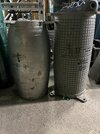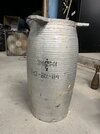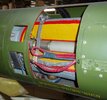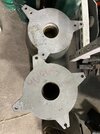British Ordnance Collectors Network
You are using an out of date browser. It may not display this or other websites correctly.
You should upgrade or use an alternative browser.
You should upgrade or use an alternative browser.
Warhead id
- Thread starter US-Subs
- Start date
Weasel Pilot
Well-Known Member
The 3N12 would be the earlier design, next would PROBABLY have been the 3N12M followed by the M1, but the Soviets, who knows...
The 3N12 is the High-Explosive FRAGmentation warhead of the 3M9 SAM system 2K12 'Kub' (SA-6 Gainful, NATO classification)
Warhead weight, kg = 57
Explosives weight, kg = 23 (TG-20, TNT/RDX 20% / 80%)
Number of fragments, pcs = 2500
Probability of destruction = 0.8
The 3N12 M1 is a modification of this warhead.
I have not found more data on this warhead but it is worthy to note that the development of the "Kub" included the 3M9M4 experimental modification for 2K12M4 "Kub-M4" with a warhead weight was increased from 50 to 70 kg - Not mass-produced. Would it be this specific warhead?
Hope this will help.
Warhead weight, kg = 57
Explosives weight, kg = 23 (TG-20, TNT/RDX 20% / 80%)
Number of fragments, pcs = 2500
Probability of destruction = 0.8
The 3N12 M1 is a modification of this warhead.
I have not found more data on this warhead but it is worthy to note that the development of the "Kub" included the 3M9M4 experimental modification for 2K12M4 "Kub-M4" with a warhead weight was increased from 50 to 70 kg - Not mass-produced. Would it be this specific warhead?
Hope this will help.
Weasel Pilot
Well-Known Member
This is out of the 3M9M1 "Cube" (Often transliterated vs translated as "Cub" from the Cyrillic "Куб") surface to air missile known in the West as the SA-6 GAINFUL. The code in the second line is typically the batch number, year of manufacture and the factory code number, but in this case, maybe not or perhaps in a different order.
Weasel Pilot
Well-Known Member
Thanks guys. This is all fairly consistent with what I’ve seen online, but does not make sense with what I’m seeing on the warhead.
Perhaps without justification, I’ve always associated the circular “beehive” warhead with earlier designs. The Kub uses a much more modern cube fragmentation. A modification of that warhead would logically be an advancement, not regression? Additionally, I have access to what I believe to be a Cub warhead here on location. It uses 4 point attachment, vs this design having only three. This sort of change would seem to me to be a major modification, more like a different model.
Perhaps without justification, I’ve always associated the circular “beehive” warhead with earlier designs. The Kub uses a much more modern cube fragmentation. A modification of that warhead would logically be an advancement, not regression? Additionally, I have access to what I believe to be a Cub warhead here on location. It uses 4 point attachment, vs this design having only three. This sort of change would seem to me to be a major modification, more like a different model.

Attachments
Thanks, first time I’ve seen this diagram. Is it possible that both warheads are part of a tandem warhead system? I’ve seen this missile as a frequent display in large museum collections, but never fully exposed and I never studied it in detail.
Eggburt1969
Well-Known Member
Thanks, first time I’ve seen this diagram. Is it possible that both warheads are part of a tandem warhead system? I’ve seen this missile as a frequent display in large museum collections, but never fully exposed and I never studied it in detail.
No 3M9 series SAMs use a tandem warheads as far as I'm aware? If you mean the thing labelled 9, this is the 9D16K (9Д16К) ramjet's solid-propellent gas (fuel) generator. It's a fuel rich solid-propellent, its unburnt part, i.e. the fuel, is fed into the ramjet's combustion chamber, where it is mixed with the hot high-pressure incoming air and burnt to produce the required thrust. It's a far simpler that using a liquid fuel design.
My reference material reportedly states the 3N12M1 (3Н12М1) warhead assembly was part of the 3M9M1 (3М9М1), 3M9M2 (3М9М2), and 3M9M3 (3М9М3) surface-to-air missiles (SAMs).
These three SAMs are respectively reportedly to be part of the 2K12M1 (2К12М1) Kub-M1 (Куб-М1), 2K12M2 (2К12М2) Kub-M2 (Куб-М2), and 2K12M3 (2К12М3) Kub-M3 (Куб-М3) SAM systems of the Soviet/Russian 'Air Defence Troops of the Ground Forces' (PVO SV [ПВО СВ]). And yes 'Kub' (Куб) translates to 'Cube' in English.
The varying diameter shape of the warhead is to due to the need to achieve a certain fragmentation pattern and fragment velocity. The shape of the warhead seen is chosen to modify the pattern and velocities of the fragments produced by a simple cylindrical-shaped warhead. The pattern and velocities of the fragments is primarily a combination of the warhead's geometry (i.e. how much explosive is behind the fragmentation casing and how much each weigh) the initiation point (i.e. the profile of the detonation wave) and the forward velocity of the SAM.
Last edited:




